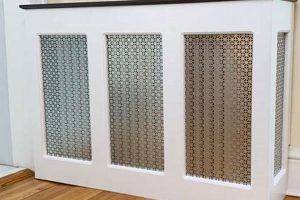Creating three-dimensional greeting cards through individual effort represents a specific craft activity. These cards, characterized by elements that elevate or extend upon opening, are produced via a range of techniques and materials selected by the card maker. An example includes constructing a card with a paper-engineered butterfly that appears to flutter as the card is unfolded.
The value of this craft lies in its capacity for personalized expression and the tangible connection it fosters between the creator and recipient. Historically, handmade cards offered a primary means of conveying sentiments before the advent of mass-produced alternatives. This practice allows for tailored designs reflective of individual relationships and occasions.
Subsequent sections will elaborate on essential materials, fundamental construction methods, and a selection of design ideas to facilitate the successful fabrication of these personalized creations. These detailed instructions serve as a guide for those interested in learning or enhancing their skills in this craft.
Essential Guidelines for Constructing Dimensional Greetings
The following recommendations are designed to enhance the creation of three-dimensional greeting cards, ensuring structural integrity and visual appeal.
Tip 1: Select Appropriate Paper Weight: Opt for cardstock of substantial weight (65lb to 100lb) for the card base to provide sufficient stability. Lighter-weight paper can be used for interior elements to allow for easier manipulation and folding.
Tip 2: Employ Precise Cutting Techniques: Accurate cutting is paramount. Utilize a craft knife and a self-healing cutting mat to achieve clean lines and prevent tears, particularly when creating intricate shapes.
Tip 3: Score Fold Lines Before Folding: Scoring creates a defined crease, facilitating a crisp and accurate fold. A bone folder or scoring tool should be used in conjunction with a ruler to ensure straight, even lines.
Tip 4: Use Appropriate Adhesives Sparingly: Select adhesives suitable for paper, such as glue sticks or double-sided tape. Apply adhesive conservatively to prevent warping or bleeding through the paper.
Tip 5: Test the Pop-Up Mechanism: Before adhering all components, test the functionality of the pop-up mechanism. Ensure that all moving parts function smoothly and without obstruction.
Tip 6: Incorporate Reinforcements Where Needed: For complex or heavy pop-up elements, consider adding reinforcement tabs or supports to prevent sagging or tearing over time.
Tip 7: Plan the Design Layout: Before commencing construction, sketch a detailed design plan. This includes determining the placement of pop-up elements, decorative features, and any written messages.
Tip 8: Consider the Card’s Enclosure: Ensure that the finished card, including all three-dimensional elements, fits comfortably within its intended envelope without being crushed or damaged.
Adhering to these guidelines promotes the creation of structurally sound and visually engaging dimensional greetings, enhancing their overall quality and longevity.
The subsequent section will address common challenges encountered during the creation of these cards and provide solutions to overcome them.
1. Planning and Design
The initial phase of constructing dimensional greeting cards, specifically planning and design, fundamentally determines the success of the final product. This phase necessitates a detailed conceptualization of the card’s structure, encompassing the placement and functionality of all three-dimensional elements. A well-defined plan mitigates potential structural failures and aesthetic inconsistencies during subsequent construction. For example, a design depicting a complex architectural structure unfolding upon opening requires meticulous planning to ensure that all elements align correctly and function as intended.
Effective planning incorporates several critical considerations. These include selecting appropriate paper types for different components, determining the precise dimensions of each element, and mapping out the folding and assembly sequences. Furthermore, the design phase must account for the mechanical properties of the chosen materials and the constraints imposed by the card’s intended enclosure. Consider the practical example of a card featuring a pop-up cake; the height and width of the cake must be carefully calculated to prevent it from exceeding the dimensions of the envelope. The success of this design also depends on accurate folds and stable joints.
In summary, the planning and design phase is not merely an aesthetic consideration; it serves as the blueprint for the entire card construction process. Thorough planning minimizes errors, maximizes efficiency, and ensures that the finished card meets the desired structural and visual standards. Neglecting this crucial step often results in cards that are structurally unsound, visually unappealing, or functionally impaired, thereby diminishing the overall impact and value of the handcrafted greeting.
2. Paper Selection
The selection of paper is a critical determinant in the successful execution of three-dimensional greeting card projects. The material’s properties directly influence the card’s structural integrity, aesthetic appeal, and functional performance. Careful consideration of weight, texture, and fiber orientation is therefore essential.
- Weight and Rigidity
Paper weight, measured in pounds or grams per square meter, dictates the card’s overall rigidity. Heavier paper stock (e.g., 80lb or higher) is generally preferred for the base of the card to provide stability and prevent bending. Lighter-weight paper (e.g., 65lb) is suitable for interior components requiring flexibility for folding and movement. The inappropriate selection of weight can result in a card that is either too flimsy to stand upright or too rigid to fold properly, hindering the intended three-dimensional effect.
- Texture and Finish
Paper texture affects the card’s tactile and visual appeal. Smooth finishes offer a clean, modern aesthetic and are ideal for detailed printing or intricate cutting. Textured papers, such as linen or felt finishes, add depth and character. The choice of finish should align with the card’s overall design theme. For example, a textured paper might be preferable for a rustic or natural-themed card, while a smooth finish might be better suited for a minimalist design.
- Fiber Orientation (Grain)
Paper grain, the direction in which the fibers align, influences the paper’s folding behavior. Folding with the grain results in cleaner, sharper creases and reduces the risk of cracking or tearing. Identifying the grain direction and aligning it with the intended fold lines is crucial, particularly for complex pop-up mechanism
s. Failure to do so can lead to uneven folds and structural weakness. - Color and Opacity
The color and opacity of the paper contribute significantly to the card’s aesthetic impact. Color choices should complement the design and convey the intended message or emotion. Opaque paper prevents show-through from underlying layers or adhesives, ensuring a clean and professional appearance. For cards with intricate designs, selecting colors that contrast well can enhance visual clarity and impact.
In summation, paper selection extends beyond a simple aesthetic choice. It is a fundamental engineering consideration that directly affects the functionality, durability, and visual quality of the finished three-dimensional greeting card. A deliberate and informed approach to paper selection maximizes the potential for creating successful and impactful greeting cards.
3. Cutting Precision
The correlation between meticulous cutting and successful three-dimensional card construction is foundational. Accurate cuts are indispensable to the functionality and visual appeal of these cards. Imprecise cuts directly compromise the integrity of the card’s structural elements, leading to misalignment, instability, and a diminished aesthetic outcome. Consider, for instance, a card designed with a series of interlocking tabs that form a three-dimensional shape. If the cuts defining these tabs are not executed with precision, the tabs will not interlock correctly, resulting in a structurally unsound and visually distorted form. This directly undermines the card’s intended effect.
The practical implications of cutting accuracy extend beyond purely aesthetic considerations. When creating intricate pop-up mechanisms, precise cuts are essential for ensuring smooth movement and proper alignment of the various components. Misaligned cuts can cause friction, impede movement, or even prevent the mechanism from functioning altogether. For example, in a card featuring a lever-activated pop-up element, the lever and its corresponding support structures must be cut with exacting precision to ensure that the lever moves freely and the pop-up element deploys correctly. Using a sharp blade, appropriate cutting tools, and accurate templates are crucial components of this process.
In summary, cutting precision is not merely a desirable attribute; it is a prerequisite for achieving functional and visually compelling three-dimensional greeting cards. Deviations from precise cutting techniques introduce cumulative errors that compromise both the structural integrity and the aesthetic quality of the card. Mastering the techniques necessary to achieve accurate cuts constitutes a fundamental skill for anyone involved in the construction of three-dimensional greeting cards.
4. Folding Accuracy
In the domain of three-dimensional greeting card construction, folding accuracy represents a pivotal factor influencing the structural integrity, aesthetic quality, and functional performance of the finished product. Precise folding facilitates the smooth deployment of pop-up elements, ensures proper alignment of components, and enhances the overall visual appeal. Deviations from accurate folding introduce cumulative errors that compromise the card’s intended design and functionality.
- Crease Definition and Sharpness
Clearly defined and sharply creased fold lines are essential for achieving crisp and accurate folds. The use of a scoring tool and a straightedge is recommended to create precise creases before folding. Ill-defined or rounded creases result in imprecise folds, which can lead to misalignment of pop-up elements and a reduction in the card’s structural stability. In a card featuring a geometric pop-up design, poorly defined creases can distort the intended shapes and compromise the overall visual effect.
- Angle Precision
The accurate execution of angles is crucial for the proper functioning of many pop-up mechanisms. For example, a card featuring a pop-up box requires precise 90-degree angles to ensure that the box unfolds correctly and maintains its shape. Deviations from these angles can cause the box to collapse or distort, rendering the mechanism ineffective. Templates and protractors may be used to ensure that angles are accurately measured and folded.
- Sequential Folding Order
The order in which folds are executed significantly affects the final outcome. Adhering to a predetermined folding sequence prevents the accumulation of errors and ensures that all components align correctly. Complex pop-up designs often involve multiple layers and interconnected elements, necessitating a carefully planned folding sequence. Deviations from this sequence can lead to structural conflicts and prevent the card from folding flat or deploying properly.
- Material Compliance
Different paper types exhibit varying degrees of compliance when folded. Thicker paper stock requires more force to achieve sharp creases, while thinner paper is more prone to tearing or wrinkling. Understanding the material properties and adjusting folding techniques accordingly is essential. For example, when working with heavy cardstock, scoring multiple times may be necessary to create a sufficiently defined crease without damaging the paper.
These elements of folding accuracy are interwoven, demonstrating that deviations in one aspect can impact the others. A well-constructed dimensional greeting card is dependent on precision and careful execution, emphasizing the crucial role that folding accuracy plays in achieving an optimal final result.
5. Adhesive Application
Effective adhesive application is a critical determinant in the creation of durable and visually appealing three-dimensional greeting cards. The choice of adhesive, its method of application, and the precision with which it is applied directly impact the structural integrity and longevity of these handcrafted items. Inappropriate adhesive use can result in component failure, visual imperfections, and a diminished overall quality.
- Adhesive Selection: Compatibility and Strength
The selection of an appropriate adhesive is paramount. Acid-free glue sticks, double-sided tape, and specialized paper adhesives are commonly employed. Acid-free formulations prevent discoloration and degradation of the paper over time. The adhesive’s strength must be sufficient to bond the chosen materials securely, particularly in areas subject to stress or movement. For example, when adhering a complex pop-up element to the card base, a high-strength adhesive is necessary to ensure its long-term stability.
- Application Technique: Precision and Minimization
Adhesive should be applied sparingly and with precision. Excess adhesive can bleed through the paper, causing unsightly stains or warping. Fine-tipped applicators and controlled application methods are recommended. Double-sided tape offers a clean and precise alternative to liquid adhesives. For instance, when attaching delicate paper embellishments, a small piece of double-sided tape applied to the reverse side provides a secure and invisible
bond. - Curing Time and Environmental Factors
Adhesives require a specific curing time to achieve optimal bond strength. Environmental factors such as humidity and temperature can affect the curing process. Following the manufacturer’s instructions regarding curing time and environmental conditions is essential. Premature stress on the bonded components before the adhesive has fully cured can compromise the bond’s integrity. In situations requiring rapid adhesion, fast-drying adhesives may be considered, with careful attention to their archival properties.
- Adhesive Visibility and Aesthetics
The visibility of adhesive can detract from the card’s aesthetic appeal. Selecting adhesives that dry clear or employing techniques to conceal adhesive application are crucial. For example, tucking adhesive tabs behind paper layers or using translucent adhesives minimizes visibility. The ultimate goal is to achieve a strong and durable bond without compromising the visual integrity of the finished card.
The various facets of adhesive application represent interconnected elements essential to the successful creation of three-dimensional greeting cards. Informed adhesive choices, precise application techniques, and careful adherence to curing guidelines contribute to a finished product of enhanced durability and aesthetic value. These considerations distinguish professionally crafted cards from those compromised by inadequate adhesive practices.
6. Mechanism Testing
In the realm of constructing dimensional greeting cards, the systematic evaluation of mechanical components is a non-negotiable element. This testing phase directly influences the final card’s functionality, ensuring that all moving parts operate as intended and that the overall design achieves its desired effect. A rigorous assessment minimizes the risk of malfunction or structural failure post-completion.
- Range of Motion Verification
This process involves assessing the full extent of movement for each interactive element within the card. The objective is to identify any obstructions or limitations in the range of motion that could impede the mechanism’s proper function. Consider a card featuring a lever-activated component; the range of motion verification would confirm that the lever moves freely and without obstruction throughout its intended path.
- Structural Integrity Assessment
This assessment involves evaluating the structural resilience of all load-bearing components within the card. The purpose is to identify potential weak points or areas susceptible to failure under repeated use. A card designed with a complex pop-up structure, for instance, would undergo structural integrity assessment to ensure that the support elements can withstand the stresses generated during deployment and retraction.
- Alignment and Synchronization Checks
This process focuses on verifying the precise alignment and synchronized movement of interdependent elements within the card. The goal is to identify any misalignments or timing discrepancies that could disrupt the mechanism’s overall function. In a card featuring a multi-stage pop-up sequence, alignment and synchronization checks would ensure that each element deploys in the correct order and at the appropriate time.
- Durability Testing Under Simulated Use
This testing involves subjecting the card to a series of simulated usage cycles to evaluate its long-term durability and identify potential failure points. The objective is to replicate the conditions of normal use and assess the mechanism’s ability to withstand repeated stress. For example, the durability testing of a card with a repeatedly opened and closed element will determine its capacity to withstand long-term usage.
Mechanism testing serves as an objective validation process, substantiating that the designed functionality aligns with the physical manifestation of the three-dimensional greeting card. Adherence to systematic testing protocols significantly reduces the potential for performance deficits, bolstering both user contentment and the longevity of the card.
7. Embellishments
Embellishments, defined as supplementary additions designed to enhance aesthetic appeal, serve as a crucial element in the creation of three-dimensional greeting cards. The purposeful integration of such additions, whether through the application of decorative paper, adhesive gems, or intricate cutouts, significantly augments the visual complexity and perceived value of these handcrafted items. For instance, a simple pop-up flower gains heightened realism and allure when adorned with glitter, textured paper petals, and strategically placed bead stamens. The careful selection and application of embellishments, therefore, transforms a basic structure into a personalized and visually engaging creation.
The effective utilization of embellishments extends beyond mere aesthetic enhancement; it facilitates the conveyance of nuanced messages and targeted emotional responses. Color choices, material textures, and the symbolic representation of chosen adornments contribute to the card’s overall narrative. Consider a card commemorating a celebratory occasion; the inclusion of metallic accents, vibrant hues, and celebratory motifs reinforces the theme of festivity and joy. Conversely, a card designed to convey condolences might employ muted tones, textured paper evoking solemnity, and minimalist embellishments to communicate empathy and respect. The strategic deployment of embellishments, therefore, functions as a powerful tool for emotional expression and message reinforcement.
In summary, embellishments constitute an integral component in the construction of dimensional greeting cards, contributing significantly to their aesthetic impact, emotional resonance, and perceived value. The successful integration of such additions requires a discerning eye for detail, a comprehensive understanding of design principles, and a deliberate consideration of the card’s intended message and audience. While challenges exist in maintaining a balance between enhancement and excessive ornamentation, the skillful application of embellishments remains a pivotal factor in elevating the quality and impact of these handcrafted expressions.
Frequently Asked Questions
The following section addresses common inquiries regarding the construction of three-dimensional greeting cards, providing concise and informative responses to enhance understanding and facilitate successful project execution.
Question 1: What constitutes the optimal paper weight for the card base?
Cardstock ranging from 65lb to 100lb offers a balance between structural stability and ease of manipulation. Lower weights may result in insufficient rigidity, while higher weights can impede folding.
Question 2: What tools are essential for achieving precise cuts?
A craft knife with a sharp blade, a self-healing cutting mat, and metal rulers are fundamental for accurate cutting. Templates and specialized cutting machines can further enhance precision.
Question 3: How can warping caused by adhesive application be prevented?
Employing adhesives designed for paper, such as glue sticks or double-sided tape, and applying them sparingly min
imizes warping. Ensuring even distribution of adhesive is also crucial.
Question 4: What measures mitigate tearing at fold lines?
Scoring fold lines before folding using a bone folder or scoring tool creates a defined crease, reducing stress on the paper fibers and minimizing tearing.
Question 5: How is proper alignment of pop-up elements ensured?
Detailed planning, accurate measurements, and the use of templates facilitate proper alignment. Testing the mechanism’s functionality before final adhesion is also advisable.
Question 6: What are the most common causes of pop-up mechanism failure?
Inadequate planning, imprecise cutting, inaccurate folding, and insufficient adhesive strength are primary contributors to mechanism failure. Thorough testing and quality control are essential preventative measures.
These answers provide concise guidance on critical aspects of three-dimensional card construction. Adhering to these principles promotes structurally sound and visually appealing results.
The subsequent section offers a comprehensive glossary of terms related to dimensional card construction, clarifying terminology and enhancing understanding.
Conclusion
This exploration of dimensional card construction has illuminated the critical factors influencing the creation of structurally sound and visually compelling three-dimensional greeting cards. Accurate planning, precise execution in cutting and folding, informed material selection, and rigorous testing are all indispensable to achieving optimal results. The successful realization of pop up cards diy projects hinges on a comprehensive understanding and careful application of these principles.
The art of crafting these dimensional greetings, while demanding precision and attention to detail, offers a unique avenue for personal expression and meaningful communication. Continued refinement of techniques and exploration of innovative designs promise to further elevate the impact and artistry of this craft. Further study and dedicated practice will allow those interested to master the art of pop up cards diy.






![DIY Build: Circular Saw Crosscut Jig PDF Plans [Free] The DIY Hub: Creative Crafts, Repairs & Life Hacks DIY Build: Circular Saw Crosscut Jig PDF Plans [Free] | The DIY Hub: Creative Crafts, Repairs & Life Hacks](https://craftingdiycenter.com/wp-content/uploads/2025/07/th-5916-300x200.jpg)
